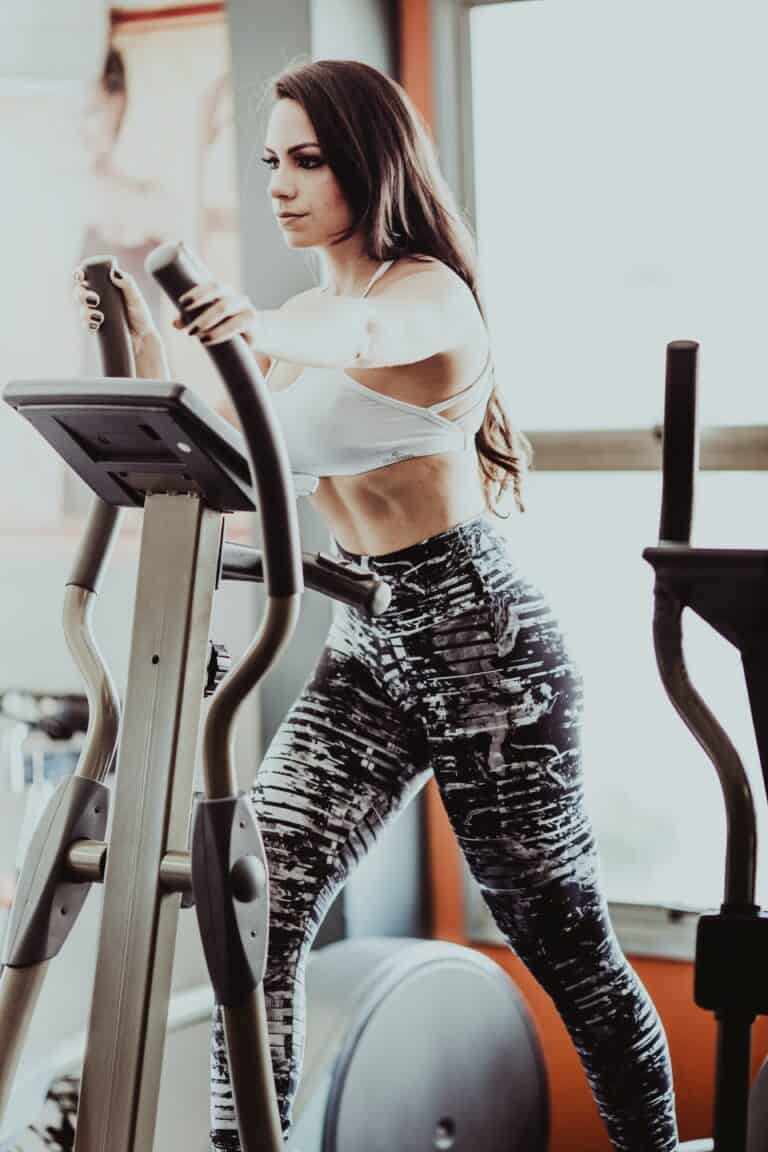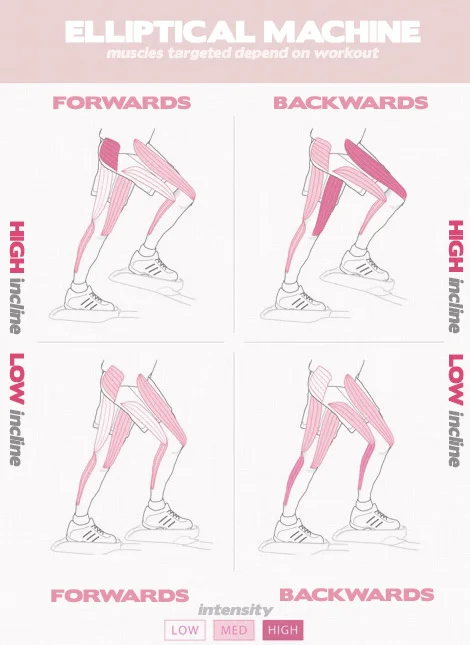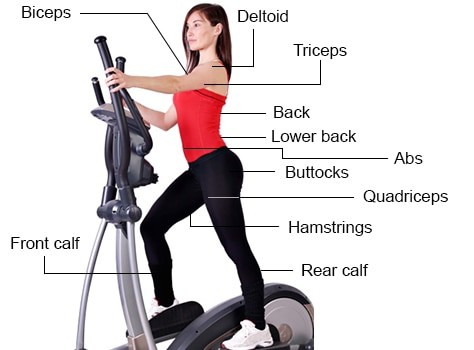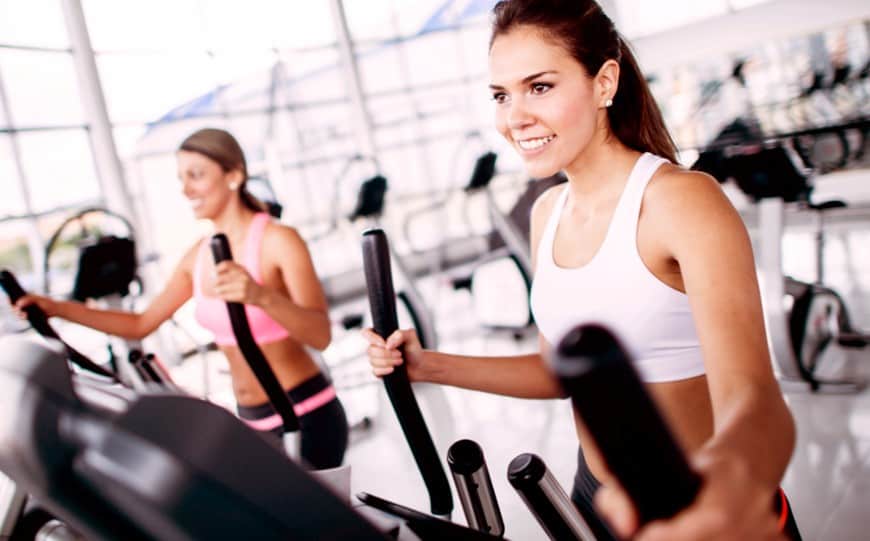What Muscles Does a Cross Trainer Work?
Cross trainers are a great overall body workout tool. Sometimes known as an elliptical, this machine takes features from a step climber and treadmill to combine them for a low impact exercise. For the best cross trainers on the market, read our comparison article.
The cross trainer target a wide range of muscles in the body while providing an aerobic workout. While working out on the cross trainer the following muscles are used – calves, hamstrings, quadriceps, glutes, arms, shoulders and abs!
Elliptical Muscle Groups
Few cardio machines allow you to work all of the major elliptical muscle groups at once, without impacting your joints.
Below we look at the main muscles worked by the cross trainer and how to use the elliptical machine to target each muscle group you wish to strengthen.

What Parts of The Body Does the Elliptical Machine Work?
The elliptical machine works a number of muscles around the body. It serves as both an upper and lower body cardiovascular workout which engages the glutes, hamstrings, calves, arms, chest, back quads and heart. Let’s look at each in more detail.
Heart
The first major muscle the cross trainer uses is the heart. As with all cardio machines the cross trainer increases the heart’s contraction strength as it pumps blood around the body, delivering oxygen to the muscles. This reduces the risk of cardiovascular disease.
Unlike other cardio equipment such as the stationary exercise bike which focuses solely on the lower body. The elliptical works upper body and lower body as you move the handlebars with your arms while pedalling. It’s important to engage in cardiovascular exercise on a weekly basis.
Lower Body muscles worked on a cross trainer:
Legs
The legs are the primary recruiter in the elliptical movement. The machine requires you to push down on the pedals.
With each thrust you force different parts of the legs to contract and extend as you propel your body forward. Let’s dive in to each elliptical muscle group in the leg to see how they are worked on a cross trainer.
Quadriceps
Located at the front of the thigh. This muscle group is made up of four major muscles: the vastus medialis, vastus intermedius, vastus lateralis and rectus femoris.
Your quads undoubtedly get a good workout on a cross trainer. When you push down the pedals, your quads flex and activate during knee extension.
You may not realise it at the time because the cross trainer engages so many more elliptical muscle groups which share the load. You can change the angle of the movement to engage the quadriceps more so than the antagonistic muscle.
If you’re a beginner and you still need to build up your endurance then a cross trainer is a great low impact cardio workout to build up your quad strength. This is also a great option for recovery if you are a runner and need a low impact active recovery day for your quads.
Here is a useful video demonstrating all of the muscles used on the elliptical machine.
Gluteal Muscles
The glute muscles or gluteus maximus extends down the lower back to your upper thighs. This muscle group is a stabiliser muscle of the hips and is made up of gluteus minimus and gluteus medius.
When exercising on a cross trainer the hip extension engages the glutes, this can be emphasized more when increasing the incline. When working out on a cross trainer you must apply force to the pedals, the movement helps build strength in the buttocks while providing stability in the hips.
Calves
Located in the lower back of the legs, the calves consist of the gastrocnemius and soleus muscles. These muscles in the calf perform plantarflexion, this occurs when you press through the ball of your foot against the pedals on the cross trainer.
Using an elliptical trainer is a cardiovascular workout and will tone your calves. But if you are looking to add mass or bulk to your calves then its important to incorporate some sort of resistance training.
The elliptical trainer alone will not help grow your calves, instead give them a lean look. You can target the calves on an elliptical, when performed at an incline the calves work even harder because the plantarflexors are engaged.
Hamstrings
Another major elliptical muscle group engaged through flexion and extension on the cross trainer is the three hamstring muscles. Located on the back of the thigh, these comprise of the the biceps femoris, semitendinosus, and semimembranosus).
Every time you bend and straighten your legs on the cross trainer you engage your hamstring. To put further emphasis on the hamstring you can again increase the incline of the machine, alternatively you can reverse pedal if your machine does not have an incline feature.
When pedalling in reverse on a cross trainer, it’s important to sit back to help keep a good posture throughout the movement. When you shift your weight to your heels this naturally recruits the hamstrings to force the pedals in a backwards motion.

Upper Body
All modern cross trainers are built with arm poles which give you the opportunity to work the muscles in your chest, back, shoulder and upper back through the pushing and pulling motion.
Back and Biceps
When you work out on a cross trainer you have the option of pushing the moving handles back and forth while you pedal. While you grip the handles and pull the handles towards you in a rowing motion your rhomboids and biceps are activated.
During elbow flexion the biceps engage while the rhomboids pull the shoulder blades together. You can get more of an upper body workout by forcing the handles to move faster when pulling them with your arms.
Due to the nature of the machine it won’t build any size or strength in your upper body. It’s still primarily a lower body dominant machine but you can still balance out the intensity during your workout by using your upper body to move the handles.
Chest and Triceps
When using the handles you start to engage your upper body during the elliptical movement. The pushing of the handles recruits the pectoral muscles and triceps.
These are located on the chest and the back of the upper arm respectively. While on the cross trainer focus the resistance more on pushing the handles forwards while pedalling.
Does the elliptical work your stomach?
Abdominals
The abdominal muscles are part of the body’s core, they provide stability for all positions. While using the cross trainer you don’t specifically target the abs, but by having a strong posture and bracing your core throughout these are worked without any extra effort.
If you want to put extra emphasis on the core, you can do this by pedalling without holding the moving handles and just hold the fixed handles. Pedal fast, focus on your balance and squeeze your abs by pulling the stomach muscles inwards.
While you do this your abs contract and this improves muscle tone in the stomach area.
Muscles Used in Cross Trainer
Below is a good illustration of the muscles used on a cross trainer. It really does provide a full body workout!

Does elliptical build muscle?
Mind Muscle Connection
Because so many muscle groups share the load during the cross trainer movement it’s easy to focus on the full body aspect rather than singling out and targeting a specific muscle group. Mind muscle connection is considered a myth by some in the fitness world, but this can be the key to getting the most out of muscle specific resistance.
Known as attentional focus, this is consciously feeling the muscle work through the range of motion. This simple act can enhance muscle fibre activation and recruitment.
The more effectively you engage the muscle, the more active they are. Research backs this suggesting that focussing intently on the target muscle as you contract can lead to an increase in size.
It’s worth noting that as this is a cardiovascular exercise the elliptical won’t build muscle, but the theory still stands that when you apply your mind to the contraction it shows greater benefit.
Workout Programme for Cross Trainer
The flexibility of an elliptical trainer means it’s simple to target specific muscle groups mentioned above. You can easily vary the movement to engage a specific muscle. For instance you can put more emphasis on pulling and pushing the moving handlebars rather than pedaling.

Or pedal in reverse, there are plenty of ways in which you can change up the exercise which we have already gone through. Here is a good workout routine to get a good total body workout with a focus on different body parts.
I have added in high intensity interval training (HIIT) to the routine. This is one of the most effective ways to lose weight so gives a great balance to this total body workout routine.
Make sure as you progress through the workout you add resistance each week. This increase in progression will keep challenging your body to improve and hit your goals.
Before you start any workout make sure you warm up properly. This can include a 3-5 minute low resistance warm up on the elliptical to increase heart rate and loosen your joints.
Workout Routine Week 1
- Cardio Workout Pull Focussed on Day 1 (30 min)
- HIIT Workout on Day 2 (20 min)
- Cardio Workout Reverse pedal on Day 3 (45 min)
Workout Routine Week 2
- Cardio Workout Push Focussed Day 1 (30 to 45 min)
- HIIT Workout on Day 2 and 3 (25 min)
- Incline Workout on Day 4 (45 to 60 min)
An ex-triathlete, fitness coach and writer with a Masters in Sports Physiology. Fitness is my passion and I've had my fair share of home fitness equipment tried and tested!



5 Comments